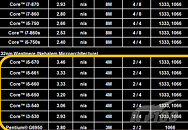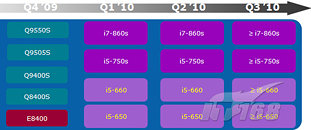Monday, August 10th 2009

Core i3, Core i5 Dual-Core Processor Model Numbers Surface
Intel is weeks away from letting loose its first socket LGA-1156 processors, starting with a series of quad-core models, namely Core i5 750, Core i7 860, and Core i7 870. According to the latest roadmaps, dual-core derivatives of the Westmere architecture, will arrive in early 2010. IT168 sourced details of the model numbers Intel chalked out, based on roadmap excepts. An older report detailed all six models based on the "Clarkdale" core, including three in the Core i5 series, two in the Core i3 series, and one in the Pentium Dual-Core series. Let's try to make sense of this branding structure.To begin with, Core i3 series dual-core processors differ from Core i5 in lacking three features: Intel Trusted eXecution Technology (TXT), a set of features that enhance security using hardware-based mechanisms. More on TXT can be read here. The second feature Core i3 lacks is Virtualization Technology for Directed I/O (VT-d), an enhancement to the virtualization capabilities (details here. Core i3 however, does feature VT-x, the regular hardware virtualization features found on today's Intel processors. The third and more relevant feature Core i3 lacks is Turbo Boost technology, a feature that assesses processor load, powers-down one of the two cores, and overclocks the active core, all automatically, and on the fly. This feature holds even more importance in quad-core and multi-socket quad-core machines, but may come handy nonetheless.Here's what the lineup stands at:
Finally, Intel's first sub-$100 Pentium dual-core offering based on this architecture will be called Pentium G6950. Clocked at 2.80 GHz, its feature-set is nearly identical to that of the Core i3, except for that it has 3 MB of available L3 cache, and HyperThreading is excluded from the feature-set. All Clarkdale based processors so far, carry TDP rating of 73W.
Source:
IT168
- Core i3 530 -2.93 GHz
- Core i3 540 -3.06 GHz
- Core i5 650 -3.20 GHz, with Turbo Boost speed of 3.43 GHz
- Core i5 660 -3.33 GHz, with Turbo Boost speed of 3.60 GHz
- Core i5 670 -3.43 GHz, with Turbo Boost speed of 3.73 GHz
Finally, Intel's first sub-$100 Pentium dual-core offering based on this architecture will be called Pentium G6950. Clocked at 2.80 GHz, its feature-set is nearly identical to that of the Core i3, except for that it has 3 MB of available L3 cache, and HyperThreading is excluded from the feature-set. All Clarkdale based processors so far, carry TDP rating of 73W.


24 Comments on Core i3, Core i5 Dual-Core Processor Model Numbers Surface
However, as a sign of "exhaustion" with over-SKUing, re-branding, even misbranding of s-1366/1156 I have to say, I have lost interest in piecing this jigsaw puzzle together. Perhaps Intel should reflect on that; if members of the enthusiast community are now somewhat disinterested at best, and confused at worst... then this will have negative customer-lifetime-value impact.
Yes, I still love Intel CPU's, and yes, I will continue to buy their premium platforms, but no, I have lost all interest in decyphering their SKU mess.
those dualcore with HT can be scary for amd!
whats wrong with intel
I think this is a deliberate attempt by Intel to confuse the public and milk a few extra bucks from the enthusiast crowd. Why else charge a 40% premium for unlocked processors as they do now?
Or maybe they realized that triple-channel memory is not all that they wanted it to be, so let's take the high end 1156 processors, call them i7 and charge accordingly. Bah! Humbug!
I think they arranged for specialists from nVidia, Dell and a few other companies to come together and make the least understandable branding system possible. Good job!
Intel wanted you to buy 65 nm Core 2 Duo chips even when E8400 arrived. So E8400 was priced $270. Later, it pushed E8400 to the $180 price point, and priced the the E8500 at $280. It now stands at E8600 being priced at $280, while E8500 and E8400 are pushed further inside. So, you are made to digest its inventories. If you want the best in the lineup, prepare to shell out more. Currently, Intel has three sweet spots drawn out:
Core i5 650 dual-core (3.20), priced at $176.
Core i5 750 quad-core (2.66), priced at $196. With HTT enabled, this chip would have you think twice before choosing i7 920, so they decided to disable it.
Core i7 920 quad-core (2.66), this chip is the shit, considering the next Lynnfield after i5 750, which is i7 860, is actually priced higher than this ($283).
Anyways, I've come to the realization that Intel is really competing with itself at this point in the general consumer marketspace. (Not just high-end enthusiast marketspace, which is obvious by now.) Phenoms and the like are really not making any sort of real impact. I mean just according to that report released yesterday, (found here) Intel's market share in x86 CPUs has risen to 80.5% while AMD has fallen even further to a lowly 18.7%. At this point AMD can account for less than a fifth of the market share, which is spread about among various CPU lineups, all of which are woefully behind the times architecturally speaking. So, yeah, I can see the point in having all these different Intel platforms around. Unless they (AMD) can come up with something tangible and innovative, I can see that 18.7% chunk shrinking even further.